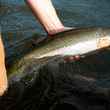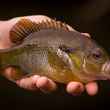Sometime in the late 1950s, an aquarium fish farm in southeast Florida — apparently dissatisfied with just selling exotic fare to enthusiasts around the U.S. — decided to deliberately introduce a small South American fish into the canals of suburban Miami.
What once swam quietly in fish tanks, navigating miniature sunken treasure chests and tiny deep-sea divers alongside those adorable neon tetras and the surly betta that just hung out in the upper corner, scowling at its neighbors, the oscar suddenly swam freely in the near-tropical freshwater canal system on the eastern edge of the Everglades.
Today, it might be the most abundant invasive fish in what has become perhaps the most manipulated plumbing system for both urban and agricultural support in the United States. The oscar (Astronotus ocellatus) is native to Amazonia, and swims abundantly in its home rivers, like the Amazon, the Oronoco and the Rio Negro. But, according to a 2018 revised report from the U.S. Fish and Wildlife Service, the oscar in its various hybridized forms makes up a big portion of the recreational fishery in south Florida. Not only is it established in the Everglades, but its largest representatives come from Lake Okeechobee and points farther north.
According to the report, the oscar remains beloved by aquarium enthusiasts, but it’s also a serious piscavore that grows quickly. When a little kid wakes up in the morning to feed the fish only to find that the guppies have mysteriously disappeared, it doesn’t take much deductive reasoning to know that the only fish still in the tank likely ate them.
“Oscars are very common in the aquarium trade. Because they grow large in aquaria and are piscivorous, individuals are likely to be released into natural waters by aquarists loath to kill their pets,” the report reads. “This likely accounts for the numerous instances of single specimen records from both temperate and subtropical states.”
Indeed, the oscar is also established in Hawaii and in the U.S. territory of Puerto Rico, where it was introduced both intentionally to provide recreational fishing opportunities, and by those who didn’t like the fact that it wasn’t happy simply gulping fish-food flakes.
Of course, the Everglades canal system — particularly on the east side of the complex where fresh water dominates — is home to dozens of invasive fish species from tropical climes the world over. The oscar is joined by predatory snakeheads, prized peacock bass, various other cichlids and tilapia subspecies, walking catfish, knife fish, surgeon fish and even freshwater jellyfish.
The oscar, like the peacock bass, seems to be a preferred non-native, and there were efforts to stock it in other states — even states like Wisconsin and Alaska. These efforts were generally unsuccessful, even in warm-weather states like Texas, Louisiana and Mississippi. In its native range, it’s prized for its table fare, and anglers in south Florida don’t seem shy about harvesting these fish, either.
The oscar’s kryptonite, it seems, is cold weather and cold water. In the Everglades, after a prolonged period of warm weather, the South American fish becomes even more numerous — it does well when there are no freezes or bouts with cold that, while uncommon, occasionally do happen. When a wintry blast settles over the Everglades, oscars are generally among the early casualties, which isn’t surprising considering its tropical origins.
I caught my first oscar in the canals and froggy waters along the Tamiami Trail recently — a palm-sized black oscar that hit a Clouser and put up an impressive battle for a fish that was otherwise average. It swam in the same water as native bream and long-nose gar, both of which also hit the same Clouser pattern (the gar, thanks to its toothy snout, didn’t stay hooked). Judging by the fight, I could see why the canals were lined with anglers the closer we got to the outskirts of Miami.
Farther west, as the glades get a larger influx of salty water from the Gulf of Mexico and Florida Bay, the canals host fewer of the South American invaders and become a fishery that’s more tuned in to traditional fare, like snook, speckled trout, redfish and baby tarpon.
And, not surprisingly, there are fewer roadside anglers (the trail is a solid on-foot foot fishery, even with the occasional encounters people have with alligators that are conditioned to seeing and not fleeing from humans) on the “salty side” of the Everglades that’s accessible by foot and vehicle.
If it’s done anything good for the Everglades — and that’s absolutely debatable — the oscar has given anglers in a largely urban area a source of both recreation and food. It’s a burrower and an ambush predator, so it’s certainly had an impact on the freshwater system of the Everglades. In fact, its presence in the canals (along with presence of tilapia) is the reason fisheries officials in Florida introduced peacock bass — the oscars were doing too well before the 1980s introduction of peacocks. In South America, the oscar is a prime source of food for the more coveted peacocks. In the Everglades canals, in a system that barely resembles its native state, the South American invaders have reprised their roles of predator and prey that originated in Amazonia.
From the pessimist’s perspective, there’s no saving the Everglades where native fish are concerned. It’s just not doable, both from an economic perspective and from a practical viewpoint. From an optimist’s standpoint, the canals on the eastern edge of the glades are just fine like they are, oscars, peacocks, snakeheads, et al. It does, indeed, function, albeit from a human-induced baseline. Fish still eat other fish. Predatory birds still eat fish. Alligators still eat fish. And, perhaps most noticeably, people still chase the fish (maybe more now than ever).
There’s hope for the hydrological function of the Everglades as efforts are ramping up to increase the freshwater flow through the River of Grass to Florida Bay. And that may be where conservationists need to hang their hats.
But the oscar is part of a system today that serves a purpose of its own. For many of the non-purists out there, what matters most is that it serves a purpose beneficial to people by providing a recreational fishing outlet and, in some cases, a source of readily available food. It also provides a dependable prey base for trophy largemouth bass (native fish, by the way) and the ever-popular peacock bass fishery that extends from the Tamiami canals well into the urban Miami area.
The challenge for conservationists? Define “function” and the work to achieve. It very likely has nothing to do with oscars and other introduced fish that do, indeed, function together. Accepting that a contrived fishery made up of introduced fish from the world over is a simple reality while working to heal the Everglades and Florida Bay by increasing water flow and water quality is probably the best possible outcome.
And maybe put oscars on the menu more often.





























Comments
Dallas More replied on Permalink
I lived in Homestead and worked on Homestead AFB and ARB from 1990 to 92 and again from 94 to 97. I regularly fished the canals on the base, in the redlands, around FL City and the old Nike Missile sites, the
Everglades, and along 41 (the original Tamiami Trail), near Ochopee, and off the Loop Road. I caught lots of Oscars and everything else. My favorite to eat were the Brown Bullhead Catfish that were thick in the canals at the Midway point at the Oasis. But, there were warning signs everywhere, articles, news reports warning not to eat the fish (any fish) due to Mercury contamination. Adults were supposedly limited to 2 times a month, and none at all for pregnant women and kids. Is Mercury contamination no longer a concern? Was it overblown back then in the 80's and 90's?
Bradley McWhorter replied on Permalink
Like to let the author of this story no for fact the Oscar was not released by something store Into the Wild to begin a journey of infestation the south Florida Canal system it was deliberately placed there by the state of Florida to battle weed control and the canals in lakes in South Florida because the fish is known for uprooting plants the Florida made the first Mistake by putting the invasive weed which they have had a problem with ever since spent millions of dollars trying to scoop it out with special of Dozer boats then they'd put Oscars in the water to uproot the plants and then the peacock bass came in to eat the Oscars at least I love catching the peacock bass so I won't complain about them but it's been one thing after another they filled their own canals with evasive species so don't blame it on the hobbyist aquarium person that's not right get your facts before you write a story like this for the public misleading information isn't a good thing
C Dover replied on Permalink
Bradley, you are getting your species mixed up. Oscars are carnivores. They do not eat plants. Tilapia is the fish that you are referring to, they are vegetarians, they eat plant matter, detritus. This is the species that was originally stocked for plant control. They invasive weed is primarily Hydrilla, which is being sprayed by tons and tons of herbicide, which poisons the waters...but that's another topic.
Bradley McWhorter replied on Permalink
Okay I never said the Oscars were put in there to eat the hydrilla Oscars are known to uproot the hydrilla and other weeds and other plants that's why they were put in there I grew up in the Kendall area my whole life iPod mini Oscars all you have to do is Google the Oscar and why it was introduced into the south Florida and you'll see what I'm talking about that it was introduced by the state to uproot the hydrilla and then the peacock bass reintroduced to eat the Oscars this is a known fact Google it one of my favorite things to catch around the Air Force Base which I spent a lot of time on what's a giant prawn shrimp in the drainage ditches along little sides of the road go out there at night with a flashlight in a gig you get those prawn shrimp or 25 of them will fill a 5-gallon bucket
Bradley McWhorter replied on Permalink
Wow I just did some Google searching and I can't believe what I have found in regards to hydrilla and Oscars I can remember reading the stories from the f w c in regards to hydrilla Oscars and peacock bass and how the hydrilla was put into the waterways to give places for baby fish fry to thrive and and then later they found it was a mistake and it overtook the canal systems and then the Oscar for brought in to uproot the hydrilla not realizing that that just made the hydrilla spread faster and the Oscars overtook and then the peacock bass brought in to eat the Oscars and then the peacock bass became a great sport fish but now you do a search on the subject and you can't find anything except for the same information everywhere that in the 50s they were both released the hydrilla an Oscars end of the waterways buy aquarium people in a aquarium Market which anytime you find the same information everywhere it's assigned headed to cover up LOL and you can't find the real story anymore it's all the same exact information everywhere you look the 50s hydrilla was released the 50s Oscars were released I sure wish I could pull up the information I've read back in the 90s about the subject but I guess it's easy to push it all off on the aquarium Hobby since there are a lot of invasive species that have been released into the waters and Florida won't have to take the blame anymore they just pushed it off on the hobbyist that's sad
C Dover replied on Permalink
I caught a few in salt/ brackish water near Chokoluskee. Snook, trout, redfish, Oscar. Same location
Pages